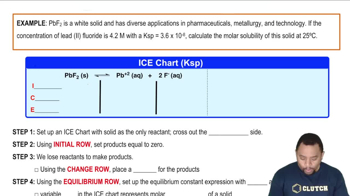Calculate the molar solubility of MX (Ksp = 1.27⨉10-36) in each liquid or solution. c. 0.20 M Na2X
Ch.18 - Aqueous Ionic Equilibrium
Chapter 18, Problem 103c
Calculate the molar solubility of calcium hydroxide in a solution buffered at each pH. c. pH = 9
 Verified step by step guidance
Verified step by step guidance1
insert step 1> Calculate the concentration of hydroxide ions, [OH^-], in the solution using the pH value. Since pH + pOH = 14, find pOH by subtracting the given pH from 14. Then, calculate [OH^-] using the formula [OH^-] = 10^{-pOH}.
insert step 2> Write the balanced chemical equation for the dissolution of calcium hydroxide, Ca(OH)_2, in water: Ca(OH)_2 (s) \rightleftharpoons Ca^{2+} (aq) + 2OH^- (aq).
insert step 3> Write the expression for the solubility product constant, K_{sp}, of calcium hydroxide: K_{sp} = [Ca^{2+}][OH^-]^2.
insert step 4> Assume the molar solubility of Ca(OH)_2 is 's'. Then, [Ca^{2+}] = s and [OH^-] = 2s from the dissolution equation. However, since the solution is buffered, [OH^-] is already known from step 1.
insert step 5> Substitute the known [OH^-] concentration from step 1 and the expression for [Ca^{2+}] into the K_{sp} expression. Solve for 's', the molar solubility of Ca(OH)_2.

Verified video answer for a similar problem:
This video solution was recommended by our tutors as helpful for the problem above.
Video duration:
7mWas this helpful?
Key Concepts
Here are the essential concepts you must grasp in order to answer the question correctly.
Molar Solubility
Molar solubility refers to the maximum amount of a solute that can dissolve in a given volume of solvent at a specific temperature, expressed in moles per liter (M). For calcium hydroxide (Ca(OH)2), this involves determining how much of the compound can dissolve in water to reach equilibrium, which is influenced by the pH of the solution.
Recommended video:
Guided course

Molar Solubility Example
pH and its Relationship to Solubility
pH is a measure of the acidity or basicity of a solution, with lower values indicating acidic conditions and higher values indicating basic conditions. In the case of calcium hydroxide, which is a strong base, an increase in pH (more basic) can enhance its solubility due to the common ion effect, where the presence of hydroxide ions shifts the dissolution equilibrium.
Recommended video:
Guided course

The pH Scale
Equilibrium and the Solubility Product Constant (Ksp)
The solubility product constant (Ksp) is an equilibrium constant that applies to the dissolution of sparingly soluble salts. For calcium hydroxide, Ksp can be expressed in terms of the concentrations of calcium ions and hydroxide ions in solution. Understanding Ksp is crucial for calculating molar solubility, especially when pH affects the concentration of hydroxide ions in the solution.
Recommended video:
Guided course

Solubility Product Constant
Related Practice
Textbook Question
Textbook Question
Calculate the molar solubility of calcium hydroxide in a solution buffered at each pH. a. pH = 4
1
views
Textbook Question
Calculate the molar solubility of calcium hydroxide in a solution buffered at each pH. b. pH = 7
Textbook Question
Calculate the solubility (in grams per 1.00⨉102 mL of solution) of magnesium hydroxide in a solution buffered at pH = 10. How does this compare to the solubility of Mg(OH)2 in pure water?
Textbook Question
Determine if each compound is more soluble in acidic solution than it is in pure water. Explain. a. BaCO3 b. CuS c. AgCl d. PbI2
1
views
Textbook Question
A solution containing sodium fluoride is mixed with one containing calcium nitrate to form a solution that is 0.015 M in NaF and 0.010 M in Ca(NO3)2. Does a precipitate form in the mixed solution? If so, identify the precipitate.
